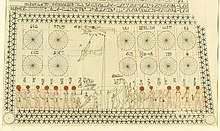Seba-en-Sah
| Seba-en-Sah in hieroglyphics | |||||||
|---|---|---|---|---|---|---|---|
| New kingdom |
Seba-en-Sah Nb3-n-S3ḥ Star of the Coming Down (toe or foot star) |
||||||
| Constellation "Sah" (Orion) | |||||||
Seba-en-Sah (also Tepi-a Sah ; First of the Descending ) is the ancient Egyptian name of Rigel ( β Orionis ), the main star of the ancient Egyptian constellation Sah .
Mythological connections
Seba-en-Sah played an important role as the namesake for the constellation Sah and as the dean's star on the ceiling in the grave of Senenmut as well as in the daily selection calendar . In the Ramesside star clocks , Seba-en-Sah represented the beginning of the fifth hour of the night on Achet IV . Rolf Krauss rejects the equation of Seba-en-Sah with Rigel because of his remarks on the Sothis cycle . His assumption that Elephantine was initially chosen as the reference point for the heliacal rise of Sirius excludes the assignment to Rigel for these reasons:
"Krauss has to do this ... because otherwise all of his calculations would be invalid ... The means to do this is to reproduce the other arguments in a distorted and essential point."
In the Ramesside star clocks, the midnight culmination is noted for the 23rd and 24th Achet III , which thus took place in the middle of the seventh hour of the night . What is remarkable about this date is the exact match to the day with the information on the ceiling representation in the grave of Senenmut , whose astronomical arrangements 1463 BC. Must have been written. It is therefore certainly no coincidence that the astronomical ceiling representations in the grave of Senenmut acted as namesake for dean orders, which were still used as copies in the Ramesside times.
Another proof for the production of copies of the ceiling representations in later times is the absence of the planet Mars , although Mars was taken into account in other texts.
Hourly scheduling
| Beginning of the ancient Egyptian night hours for Seba-en-Sah in 1463 BC. Chr. | ||
| Night hour | Egyptian calendar | Gregorian calendar |
|---|---|---|
| 12 | 1. Achet I | August 11th |
| 10 | 1. Achet II | September 10 |
| 8th | 1. Achet III | October 10th |
| 7th | 16. Achet III | October 25 |
literature
- Christian Leitz : Ancient Egyptian star clocks . Peeters, Leuven 1995, ISBN 90-6831-669-9
- Alexandra von Lieven : Floor plan of the course of the stars - the so-called groove book . The Carsten Niebuhr Institute of Ancient Eastern Studies (among others), Copenhagen 2007, ISBN 978-87-635-0406-5

